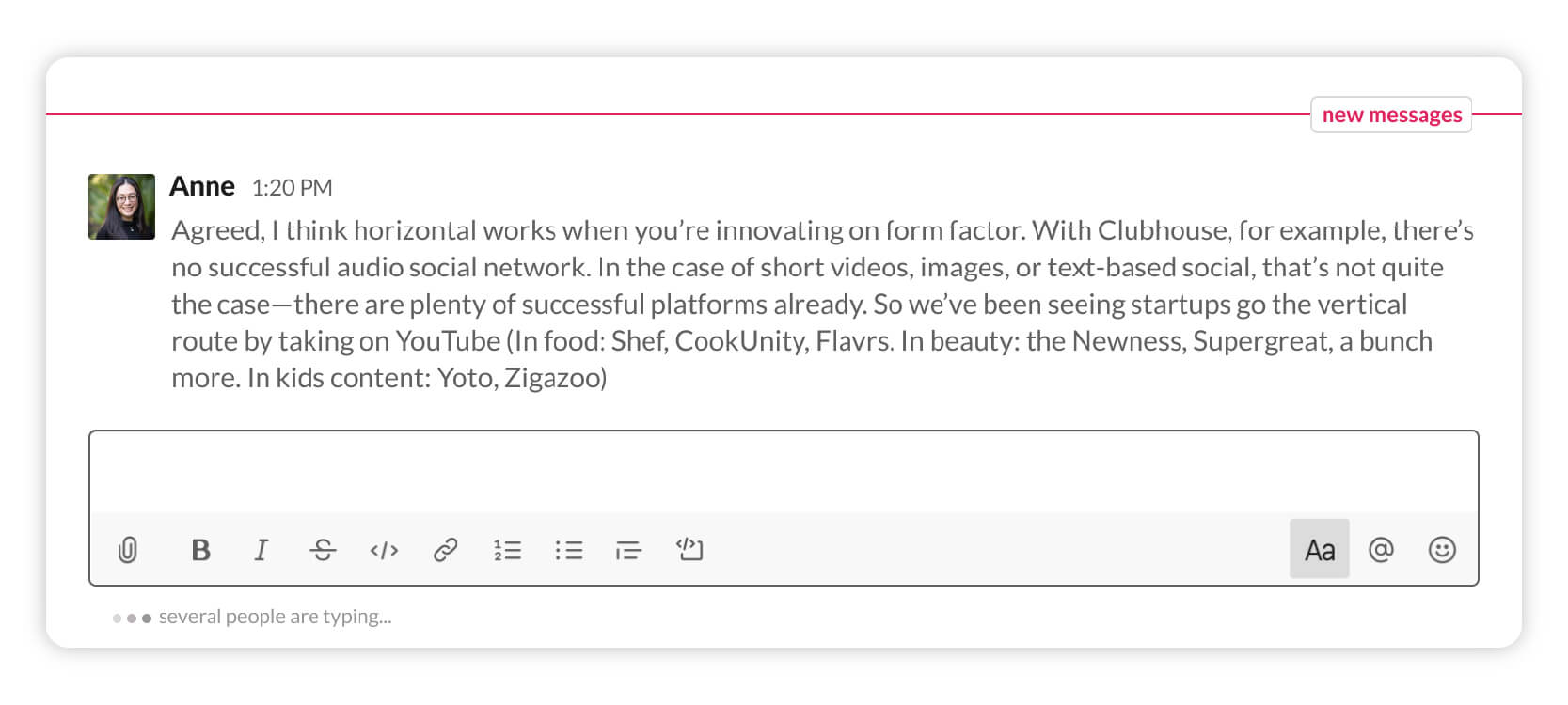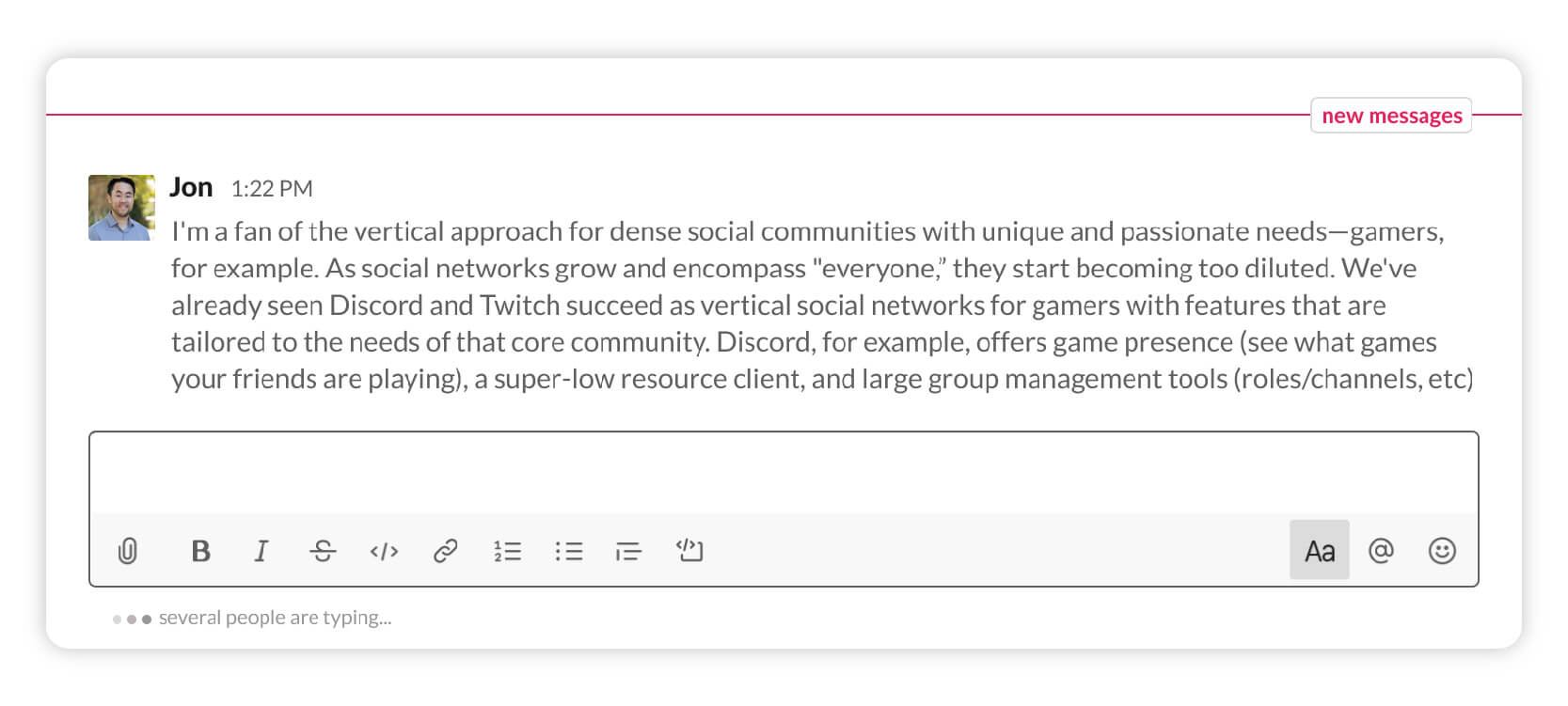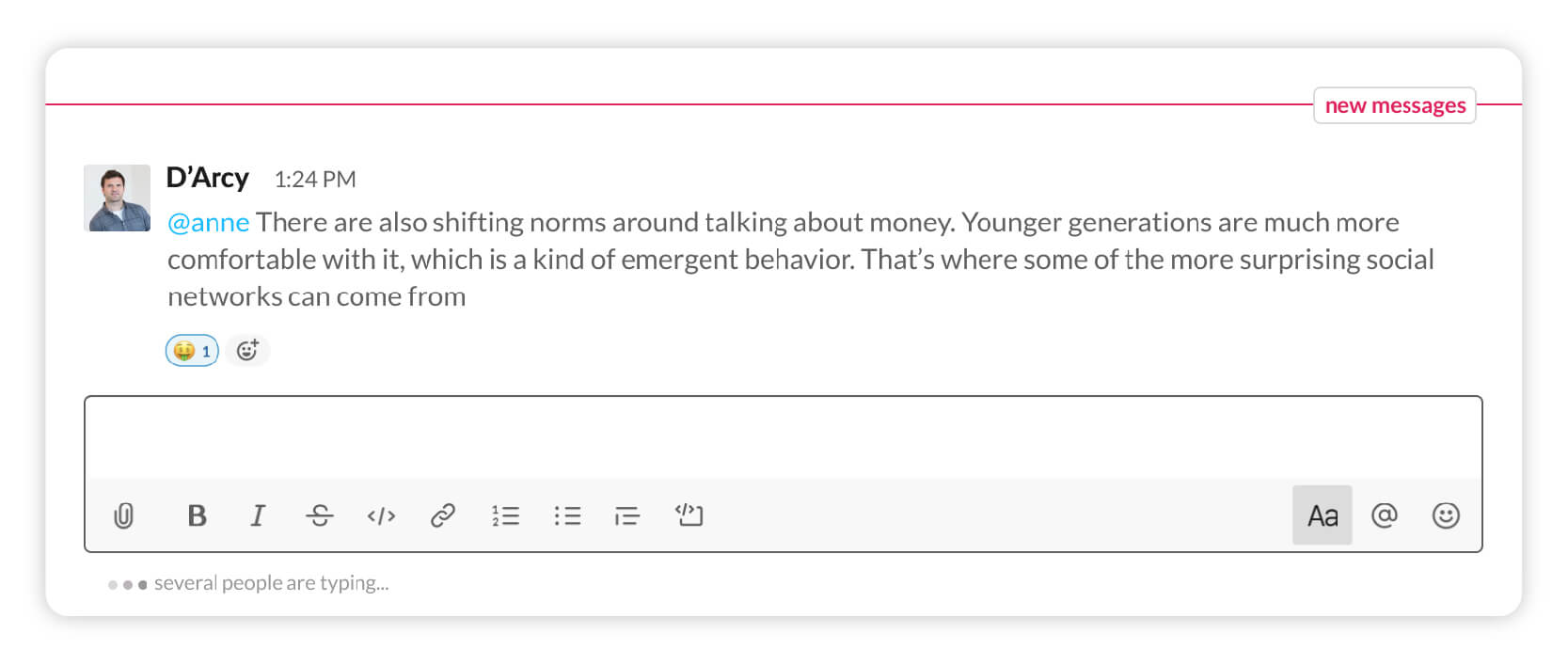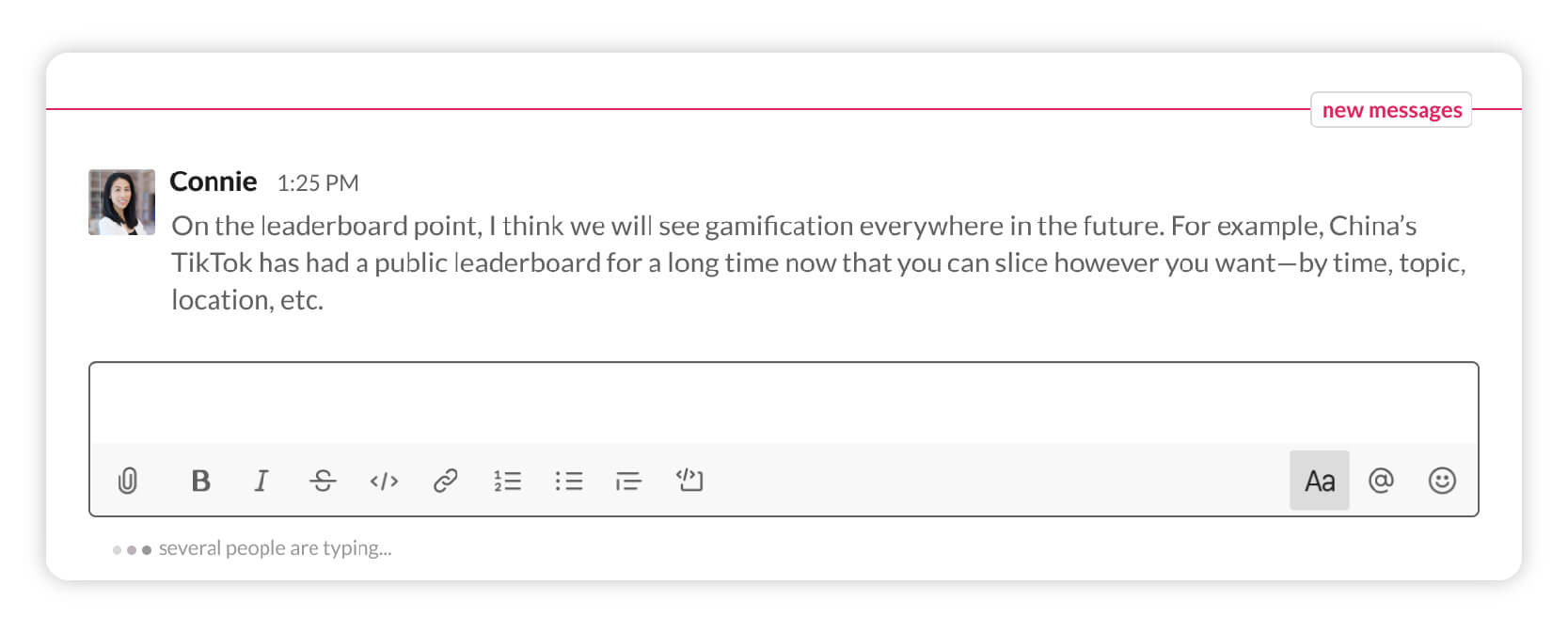Social Strikes Back is a series exploring the next generation of social networks and how they’re shaping the future of consumer tech. See more at a16z.com/social-strikes-back.
The Big 3 social networks—Facebook, Twitter, and Instagram—are massive and horizontal: everyone goes to the same place. So should entrepreneurs attempt to steal away a chunk of that market or rip it apart and go vertical? An a16z consumer team Slack debate.
Connie: Similar to fintech and banking, I think people try to find one wedge—one feature to unbundle and possibly personalize to a specific vertical of users—but often have the ambition of rebuilding a big destination platform that goes beyond that first type of user.
D’Arcy: It’s hard to compete with big social networks head-on these days. The network effects of those giant social networks are so strong, a straight-on challenge seems, well, challenging. But there is lots of opportunity to focus on one user niche or one specific form factor.  Jeff: There’s been a lot of success with the vertical approach in marketplaces, too. Craigslist has been ripped apart category by category (home sharing, ride sharing, classifieds). And eBay lost a number of big categories—tickets (Stubhub, before they bought them), collectible sneakers (GOAT), sports gear (StockX).
Jeff: There’s been a lot of success with the vertical approach in marketplaces, too. Craigslist has been ripped apart category by category (home sharing, ride sharing, classifieds). And eBay lost a number of big categories—tickets (Stubhub, before they bought them), collectible sneakers (GOAT), sports gear (StockX).
Connie: Right, it’s similar in fashion. Poshmark and RealReal basically have fashion-specific search granularity that makes them a better shopping experience than buying clothes on Mercari or eBay.
To Anne’s point, a new form factor (mobile) is also a big reason why OfferUp can take on eBay.
D’Arcy: is it easier to branch out of a niche in marketplaces vs. social networks? Andrew: I do think marketplaces are a good metaphor for social. it’s intuitive that one is applicable to the other.
Andrew: I do think marketplaces are a good metaphor for social. it’s intuitive that one is applicable to the other.
The central thing that unites them is that they’re both networks. People show up to a social network because their friends and favorite creators are on there, and buyers show up to marketplaces because the sellers are there. To reach a critical mass of community in order to be stable and grow, you generally need to pull together a cohesive group right away.
D’Arcy: To go vertical, cater to a “niche” community and build all the tools/features they would need Connie: Twitch is a great example. Discord, too. In theory, both can branch out beyond gaming—and go into livestream shopping even! They have the infrastructure to do it.
Connie: Twitch is a great example. Discord, too. In theory, both can branch out beyond gaming—and go into livestream shopping even! They have the infrastructure to do it.
The question is whether the founders have that broader ambition—and if they are able to broaden their marketing. In the Twitch and Discord examples, I actually think the marketing/branding is solvable, but the leadership team might be too focused on games for now.
Jon: I do think it’s ironic that when vertical networks grow up, their path to continued growth is to expand horizontally. Discord’s current focus is actually on expanding outside of games to dense, passionate, “games-adjacent” communities—things like TV/film, tabletop games, anime, comics, etc—instead of trying to go too far afield.
Connie: Gaming → collectibles is natural, but something like gaming → fitness is probably less so.
Jon: Exactly. I think you can succeed best with horizontal expansion when your new verticals overlap with your existing audience.
Jeff: To Connie’s point, I do think ambition is incremental. GOAT’s CEO told me a few years ago his ultimate ambition was to own the marketplace for shoes. He’s since gone more expansive.
Connie: Yes, that’s also a great example of how vertical vs. horizontal strategy is specific to the leadership team. GOAT had a broader ambition early on.
Bennett: It is interesting that so many founders strive to build vertical communities or marketplaces, but eventually hit a point where they go wider in order to expand TAM. @jon, What was Discord’s vision early on?
Jon: Discord was hyper-focused on serving the hardcore gamer community. It was a tool built by gamers for other gamers that ended up evolving into its own proprietary graph, then network. Which, to Connie’s point, makes expanding horizontally outside games a branding challenge.
Andrew: Branding is important, but timing is generally more so
Connie: Brand matters, but liquidity/inventory matter, too. I think it depends on the sector.
Jeff: Agree on the inventory/utility point. There are companies that appear to do well with decent branding, but poor brand Andrew: A friend of mine who was part of the founding team at MySpace once told me: You know the saying that a good experience causes you to tell one person, but a bad experience makes you tell five? MySpace was the beneficiary of the latter. People came to the site, saw folks posting scandalous personal photos, and told everyone… who would say, “ew that’s gross,” and proceed to sign up
Andrew: A friend of mine who was part of the founding team at MySpace once told me: You know the saying that a good experience causes you to tell one person, but a bad experience makes you tell five? MySpace was the beneficiary of the latter. People came to the site, saw folks posting scandalous personal photos, and told everyone… who would say, “ew that’s gross,” and proceed to sign up
Anne: It seems like most social networks started with horizontal features, but a specific niche community—Facebook for college kids, Twitter and Instagram for a tech crowd…are there social companies that truly started broad?
Jeff: There’s a lot of startup energy around building a sports-related social network.
D’Arcy: Going too broad too early can be tough. Some of the more interesting sports-oriented social companies built games and very “sports-specific” features into the network, rather than relying just on content
Andrew: In Eugene Wei’s “status as a service” essay, he talks about how social networks, over time, create a class of “old money”—creators who are good at creating for a particular format, and with enough followers, end up generating more followers. That makes it less friendly for new users to show up—they’re better off finding a different platform or format to succeed.
And as a result, it’s more likely that a new community will split off. He has a point: if your new social thing just recreates the same status hierarchy, it won’t work. Instead, by asking people to make a new kind of content (talk audio, or TikTok dances, etc), you rearrange the status hierarchy so a new class of creators can succeed. I found that observation very astute!
Anne: So what dense + passionate vertical interest groups are we interested in seeing founders build for?
D’Arcy: Gamers as communities are getting bigger and bigger every year
Connie: One thing about gaming is you play with other gamers, rather than solo (for most popular games, at least), so the group aspect seems especially strong in comparison to something like shopping. Or art.
Jon: To your point, I think if you’re building a vertical social network, you need verticals that are inherently social—that people like to talk about. Otherwise, it’s too hard to force connections and conversation around it
Bennett: Agreed. For digital vertical communities, there either has to be something inherently social about the underlying interest or there need to be IRL communities that already exist
Jon: @anne I’m personally very interested in the sneakerhead community. Millions of people collect sneakers and love talking about them. There’s a cult following around specific athletes and the shoes they wear. So it sort of crosses over into pop culture and sports, as well—all things people like to socialize and talk about
Jeff: @anne Service “marketplaces” have been interesting to watch over time. The horizontal approach feels intuitive, but has been challenging for a lot of companies, probably since the requirements of the different verticals are so different in terms of info needed to quote, frequency, inside vs. outside the home, etc. Vertical service marketplaces can optimize around one or a few adjacent verticals, but the low frequency of most verticals (other than cleaning and lawn care) creates challenges.
Andrew: @anne We’ve continually been interested in various forms of “work.”
Jeff: There are a ton of efforts to take different categories of vertical jobs off LinkedIn.
Andrew: Exactly. That might look like something that ultimately competes with LinkedIn, or a slice of the use-case, like what Lunchclub does. But I think it’s equally interesting to look at communities of professionals in design, engineering, etc. I think those professional groups can ultimately look like social communities, as well as labor marketplaces  Jon: Great point, @darcy. I do think money and personal finance is a surprisingly social topic these days, especially with younger generations. Swapping stock tips and credit card offers may be the new comic book trading?
Jon: Great point, @darcy. I do think money and personal finance is a surprisingly social topic these days, especially with younger generations. Swapping stock tips and credit card offers may be the new comic book trading?
D’Arcy: Fitness is another super-interesting category, since there are dense/passionate communities IRL. We’re just starting to see that move online.
Jon: My conjecture around personal fitness is that maybe not enough people like to talk about it. Personal nutrition and weight gain/loss end up being private topics, rather than ones you’d typically share with strangers
Anne: Well, Strava is doing very well in the fitness category
Bennett: @jon The community-set may not be as wide as, say, gaming, but that doesn’t necessarily mean a huge company can’t be built
Connie: Fitness is also one where there’s some “expertise” that can be shared. So you aren’t just looking for friendship, you’re also looking for tips and best practices
Andrew: Peloton has a very strong utility value to it. I’m excited to see them lean more into the social/community features, too.
D’Arcy: Totally agree. I think Peloton has lots on social/community just waiting to be tapped
Bennett: Peloton’s hardware hook (and perceived switching cost) is brilliant. Sustained motivation in fitness is a very hard problem to solve.
Jeff: What makes Peloton work is really well-executed gamification. The leader board is genius. Then there’s shared content. In social, it feels like it’s very helpful to have shared content—specific gameplay, specific media, etc. Andrew: @connie, Related to fitness, there’s an intriguing trend around edtech—a lot of people trying to learn the same thing, whether it’s how to program or how to cook, etc.—that combines blogging/content, education, and forums/chat. That’s gotten a huge boost from shelter-in-place during COVID.
Andrew: @connie, Related to fitness, there’s an intriguing trend around edtech—a lot of people trying to learn the same thing, whether it’s how to program or how to cook, etc.—that combines blogging/content, education, and forums/chat. That’s gotten a huge boost from shelter-in-place during COVID.
Anne: One last question: Does the tool come first, or the network? What works?
Andrew: In a world where people are doing so much communication over video, I think there will be many new variations on video beyond what we have. I think we’ve figured out that a YouTube clip, a TikTok dance video, and a Snap story are all technically video, but they have very different contexts and motivations. I wouldn’t be surprised if we find a dozen more video “formats” that have their own distinct set of social interactions around it
Anne: Would be interesting to expand on those different video “formats” and motivations—maybe that can be our next Slack debate!
Everything you thought you knew about social networks is getting reinvented.
Our new series, Social Strikes Back, explores the hyper-social future of consumer tech.
See more
-

Jeff Jordan is an a16z General Partner focused on consumer companies.
-

Connie Chan is a General Partner at Andreessen Horowitz where she focuses on investing in consumer technology.
-

Andrew Chen is a General Partner for A16Z GAMES, focused on the intersection of tech and gaming — this includes AI, studios, infrastructure, and consumer apps.
-
D'Arcy Coolican D'Arcy Coolican is a partner on the investment team where he focuses on marketplaces, social networks, and consumer technology companies.
-

Jonathan Lai is a general partner and founding investor of A16Z GAMES at Andreessen Horowitz, where he focuses on investing at the intersection of games and consumer, social, web3, infrastructure, and fintech.
-
Bennett Carroccio Bennett Carroccio is a partner on the venture investing team, specializing in early stage and venture consumer-facing technology investments. His focus areas include vertical marketplaces, real estate (proptech), logistics, and social networks.
-

Anne Lee Skates is a partner on the consumer investing team, where her interests include gen-Z consumer trends, retail and commerce infrastructure, and the future of cities.


